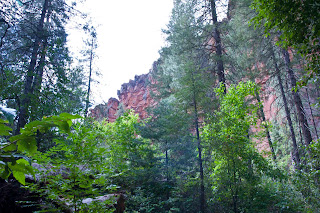Wednesday we took a drive to Sunset Crater and Wupatki National Monuments north of Flagstaff. The crater was formed about 1000 years ago. In a one year time frame this volcano grew over 1000 feet, belching cinders and lava flows which covered the surrounding landscape.
This cataclysmic event disrupted the people who inhabited the region forcing most to abandon their homes and move elsewhere. A hundred years later some returned to farm. They settled at the Wupatki pueblo which they constructed in the desert below the crater.
They must have been hardy people to live in this high desert environment. The area surrounding the crater is covered with hardened lava and now is covered with an emerging Ponderosa Pine forest at the higher elevations. As we descent from the crater toward the pueblo at Wupatki we pass from the pine forest to a landscape dominated by One Seed Juniper and grasses. A further drop in elevation and we are in a desolate, desert environment.
This is where they pueblo was constructed. It was interesting to see where this village was placed. Strategically they chose a ridge line that provided the high ground for defense. The buildings used the large boulders which lined the ridge as the foundation and then they simply stacked the flat sandstone rocks one atop the other and held them together with mud.
Between the walls they used rubble to fill the void which served as insulation from heat and cold. Below the village were two circular kivas which were used for religious ceremonies.
In the distance one can see the Painted Desert with its hues for red and white earth. Here it was hot—and one wonders why they chose this desolate, dry land for their home.
Thursday was hiking day. We left early so we could reach the Oak Creek Canyon hike before it became hot. On arrival we were greeted by a very gruff attendant who demanded a $9.00 entry fee. I offered my Parks Pass and was abruptly notified that it would not work here. This trail was under the direction of a private company and they did not honor the pass. So I paid the fee and then asked if they had a trail map. Yes, for a mere $1.00 I could have one. The map I was given was about the size of a post card and not really very informative. Nevertheless, we headed up the canyon trail which I must say was breathtakingly beautiful. The tail follows the west fork or Oak Creek up the canyon. Oak, Sycamore and Ponderosa Pine along with huge Cottonwood trees line the trail. Towering 500 feet overhead are massive rock cliffs providing an imposing spectacle. As the trail twist and turns up the canyon you must make several crossings of the creek. There are no bridges and you must carefully step from rock to rock to keep from getting wet. Ermine went part of the way with me and then decided to turn around and go back and read instead. I continued up the trail, however, I didn’t make to the top which is 3 miles one way. Instead I made it about 2 before turning around. Below are some photos of the canyon as you hike up the trail.
I imagine this would be a great birding trail in early May as the resident breeding birds and migrants return. It is now late August so many have already departed for warmer climes. I did get great looks at Red-faced, Virginia and Olive Warblers, Steller’s Jay, Lesser Goldfinch, and a pair of Western Tanagers. I could hear many other birds in the canopy but could never get enough of a look to identify them. I am considering a TOS trip to this area next May and I have asked Rhandy Helton to join me as a co-leader. The plan would be to fly into Phoenix, rent vans, pick up the participants at the airport and drive to Flagstaff; it is only 150 miles of interstate from Phoenix. There are many areas of birding interest in this area and we have never had a TOS trip to the region. The reminder of our day we planned to visit Slide Rock State Park to have our picnic and swim. Unfortunately, the monsoon rains had other plans. As I returned from the trail it was lightening and then the rain started. We decided to forgo the swim and return to camp. This would be our last outing in the Flagstaff area as we are leaving for California on Saturday morning.
Friday we headed to Flagstaff to the movies. “The Help” was our choice and what an indictment of the South it was. My father was born in Mississippi and I had the occasion to visit my Great Grandmother there in 1952. I can tell you from my experience that blacks in Mississippi were treated with great disdain. I remember seeing a sign on the outskirts of town that said “Nigger don’t let the sun set on you in this town.” I grew up in Corpus Christi, Texas which had a very small black community and one isolated from the rest of the community. It wasn’t until my senior year that we had a black student in our school. As a result I was somewhat oblivious to the segregation and its consequence for blacks in the South. I am glad that this chapter in American History in almost shut. Today I have two beautiful grandchildren whose father is black and I am very proud of them.

















































